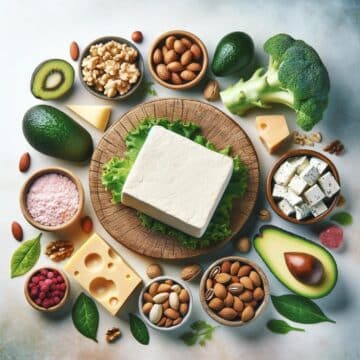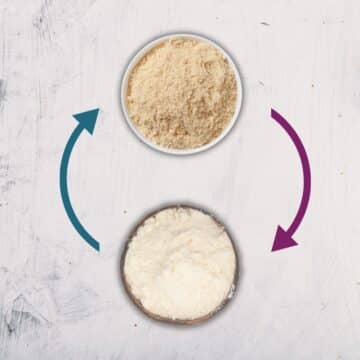Embarking on your keto baking journey can be both exciting and a bit intimidating, especially when it comes to choosing the right keto flour. Unlike traditional baking, where wheat flour reigns supreme, the low-carb world of keto baking introduces a diverse array of flour alternatives, each with its unique characteristics and uses.
Navigating this new terrain means not only swapping out wheat flour but also understanding the nuances of keto flour options and how they interact with other ingredients. Mastering the art of keto flour selection and quantity adjustments is key to achieving delicious, low-carb baked goods that don’t compromise on texture or flavor.
Discovering Keto-Friendly Flours for Healthier Baking
For many keto enthusiasts, nut flours like almond and coconut are the go-to substitutes for traditional wheat flour. These staples form the foundation of numerous low-carb baked delights. However, the keto baking landscape offers a wider array of alternatives that can yield exceptional results and infuse your diet with valuable nutrients—a top priority for many adhering to a ketogenic lifestyle.
But as you embark on this journey, it's equally important to know which flours to avoid. The market is often cluttered with misleading claims, making it challenging to distinguish between keto-friendly and non-keto flours. Some flours, despite their healthful appearance, may contain higher carbohydrate content than suitable for a keto diet.
This guide to keto flours is designed to help you make informed choices, selecting the best options for your lifestyle and learning how to bake the keto way, while also being aware of which flours to avoid.
Mastering Keto Baking: Harnessing the Potential of Low-Carb Flours
Understanding the unique characteristics of keto flours is key to successful low-carb baking. Unlike traditional wheat flour, which forms gluten networks when mixed with water—giving dough elasticity and allowing it to rise—keto flours lack these properties. They are devoid of gluten and sugar, which means they won't exhibit the same rising and elastic qualities when combined with yeast and water. However, with a few clever techniques, you can mimic the taste, appearance, and texture of wheat-based recipes using low-carb flours.
Direct substitutions with wheat flour aren't feasible due to these differences. Instead, it's often necessary to modify recipes or create new ones tailored to the properties of keto flours. For beginners, it's advisable to start with established keto recipes for baked goods like muffins, pancakes, cakes, and bread to get a feel for these unique flours.
Here are some practical tips for using keto flours effectively:
Tip #1: Almond Flour as a Close Substitute
Almond flour can often be used as a 1-to-1 substitute for wheat flour in many recipes. However, it may result in a spongier texture when used alone.
Tip #2: Moderation with Coconut Flour
Coconut flour is highly absorbent due to its soluble fiber content. The general guideline is to use only ¼ cup of coconut flour for every cup of wheat flour.
Tip #3: Combining Almond and Coconut Flour
A popular approach in keto baking is to use a 3:1 ratio of almond to coconut flour. This blend provides an optimal balance of structure, moisture, and flavor, often reducing the need for additional eggs.
Tip #4: Thicker Batters are Key
Keto batters should be thicker than traditional ones. Resist the urge to thin them out with extra liquid, as this can lead to undesirable results.
Tip #5: Generosity with Eggs
Eggs play a crucial role in keto baking, compensating for the lack of gluten and yeast. Most keto recipes call for a higher number of eggs than standard recipes.
Tip #6: Achieving Soft and Airy Textures
For those missing the soft and airy texture of traditional cakes and bread, consider keto recipes that incorporate wheat gluten and inulin. Wheat gluten is low in carbs, while inulin, an indigestible fiber, aids in yeast fermentation.
By embracing these tips and understanding the nature of keto flours, you can unlock a world of delicious and healthy low-carb baked goods.
Exploring the Diversity of Keto Flours: Finding Your Perfect Match
Keto baking flourishes with a variety of flour types, each with its unique properties and benefits. Broadly, these fall into four categories:
- nut
- seed
- fiber
- legume
Here's a breakdown to help you choose the right flour for your keto culinary creations:
Nut flours have a nutritional profile that fits keto macros perfectly: they're high in fat, moderate in protein, and low in carbs. When combined with the right ingredients, they can create tastes and textures that remind of wheat-based foods.
Seed flours can include sunflower flour, sesame seed flour, and flaxseed meal. They can replace nut flours in some cases if you suffer from nut sensitivities or allergies. They're also generally cheaper than nut flours.
Fiber flours include konjac flour, psyllium husk, and oat bran flour. Konjac is a root veggie with a high fiber content that can replace starch (and even flour) in keto baking and cooking. Oat bran flour, not to be confused with oat flour, is a low-carb and high-fiber food. It contains insoluble fibers and can work in place of whole wheat flour in recipes.
And finally, there's one legume flour being touted as a fantastic ingredient for keto baking, and that's lupin bean flour. Unlike most beans, lupin beans don't contain starch. Flour made by drying and grinding these beans is high in protein but low in carbs. Using it in keto baked goods in small amounts can enhance their properties or work as an egg replacer.
Ruling the Flour Game: Top Keto Flours for Heavenly Baked Goods
On a keto diet, you want to have the absolute best. Quality ingredients result in tasty meals. When you're able to enjoy your meals, you're more likely to stick to your diet. And besides, quality counts where health is concerned. With that in mind, here are the best keto flours to buy today:
Almond Flour: The Keto Champion
Almond flour being a keto diet staple, it's hard to imagine keto baking would be possible without it. With its mild, sweet taste, flaky texture, and off-white hue, it's the closest thing to regular flour for the low-carb eater.
Made by finely grinding blanched almonds, almond flour is sold at most health food stores, some grocery stores, and online. [1].
Besides being very low in carbs, almond flour provides lots of fat, protein, vitamin E, magnesium, and manganese. In addition, almonds are known to lower cholesterol, boost satiety, and even work as prebiotics [2].
While it's best to purchase almond flour from stores, you can make your own at home. You'll just need to add blanched almonds to a high-power food processor and grind until powdery. Another alternative is to use almond meal where appropriate or to use different nut flours, like acorn flour or walnut flour.
Nutrition info (1oz/28g):
163 calories | 14g fat | 2.6g net carbs | 6.1g protein
Coconut Flour: A Low-Carb Baking Essential
Coconut and low-carb diets go hand-in-hand. That's why you'll see loads of keto recipes using coconut oil, coconut milk, desiccated coconut, and coconut flour!
While most coconut products are high-fat, not so much coconut flour. You see, coconut flour is essentially a by-product of coconut milk production. The solids left after coconut milk extraction are dried and ground up into a fine powder we call coconut flour.
The end product is defatted considerably, but it's still nutritionally appealing [3]. There is almost 5g of protein and only 6g of net carbs in a 2 tablespoon serving. While the 6g of net carbs may seem like a lot to some, keep in mind that coconut flour is used sparingly in most recipes. It's very high in fiber and tends to expand and absorb water like crazy.
And as far as health benefits go, it can help decrease blood glucose, triglycerides, and blood pressure, according to one clinical trial published in 2015 [4].
Nutrition info (1oz/28g):
124 calories | 4.2g fat | 6.1g net carbs | 4.9g protein
Konjac Flour: A Keto Game Changer
Konjac flour is one unusual ingredient we think can make a huge difference in your keto lifestyle. Konjac flour is essentially unpurified glucomannan. It is what miracle noodles are made of.
This high-fiber, low-carb flour is made from a fibrous root veggie. You could use it in place of regular flour in some recipes, notably in pasta and noodles. But in most cases, people use it in place of starch in soups, puddings, cookies, and other desserts.
Konjac flour can make for fluffier and softer baked goods and can help thicken creams and sauces. It's also a great alternative to gelatine.
Nutritionally speaking, it's very low in calories but high in fiber [5]. Use it sparingly because it is known to be an effective laxative — up to 10g per day should be safe [6].
Nutrition info (100g):
6.5 calories | 0g fat | 0g net carbs | 1.64g protein
Lupin Bean Flour: A Protein-Rich Keto Marvel
If your keto journey has you searching for natural, high-protein ingredients, then lupin bean flour is set to become your new favorite. This flour, derived from lupin beans, is a unique entry in the keto pantry, given its legume origins. However, it defies the typical high-carb profile of legumes by being virtually starch-free. Instead, it's packed with protein, healthy fats, and fiber, making it a standout choice for those on a keto diet.
This low-carb flour alternative is completely keto-friendly despite coming from a legume. That's because lupin, the legume in question, does not contain any starches. Instead, it's high in protein, fat, and fiber [7]. The resulting flour has a mild taste when cooked and an appealing golden hue. It's great as an egg substitute in keto baking and helps add moisture and texture to doughs, batters, and more.
Nutrition info (100g):
243 calories | 11.5g fat | 0g net carbs | 36.3g protein
Sunflower Seed Flour: A Nut-Free Keto Baking Star
For those on a keto diet who are allergic to nuts or prefer nut-free options, sunflower seed flour emerges as a stellar alternative. It's important to consult with a healthcare professional about potential cross-reactivity if you have tree nut allergies, but for many, sunflower seed flour offers a safe and tasty solution.
One of the standout features of sunflower seed flour is its resemblance to almond flour in both taste and texture. This makes it a seamless substitute in most keto recipes, allowing for versatility and creativity in your low-carb baking. Furthermore, it's incredibly budget-friendly and easy to make at home. Just blend raw sunflower seeds in a high-powered blender until you achieve a fine, flour-like consistency.
While sunflower seeds are known for their omega-6 fatty acid content, incorporating them into a keto diet that includes a diverse range of fats can provide nutritional balance. This flour isn't just a workaround for nut allergies; it's a choice that brings its own set of benefits to the table.
Nutrition info (10z/28g):
164 calories | 14.4g fat | 3.2g net carbs | 5.8g protein
Acorn Flour: Nature's Keto Gift Right in Your Backyard
What if you happen to have a vast source of keto flour in your own backyard? Look for oak trees and think about it. Yes, acorns can be made into acorn flour suitable for the keto kitchen!
Acorn flour has a bit nutty and somewhat sweet taste. like chestnut. This means you might need to use less sweetener in a recipe. Great news, right?
The even greater news is that you can make acorn flour at home. It takes being in a DIY mode and feeling kind of adventurous but it feels absolutely fabulous to be able to make your own keto flour at home.
The work required to make acorn flour is worth it for all its health benefits. It is a source of calcium, phosphorus, potassium, niacin, vitamin B6, vitamin A, manganese, and linoleic and linolenic acid.
Nutrition info (100g):
501 calories | 30.2g fat | 50.8g net carbs | 7.5g protein
50.8g net carbs seem like a lot, but keep in mind 100g is way more than a typical serving. A typical serving of acorn flour would have about 15 g net carbs.
Diverse Keto Flour Options for Creative Baking
While the top six flours are popular in the keto world, several other flours also deserve the spotlight for their unique properties and versatility:
- Flaxseed Meal: A treasure in the keto kitchen, flaxseed meal is derived from nutritionally dense flax seeds. Rich in healthy fats and fiber, this meal can be easily made at home, allowing you to choose between golden or brown flaxseed varieties. Its versatility makes it an excellent addition to a wide range of keto recipes.
- Sesame Seed Flour: Boasting one of the highest fat contents among seeds, sesame seed flour is a keto favorite. While commercial varieties are often defatted, making your own sesame seed flour at home is simple and retains all the natural fats. Just grind whole sesame seeds in a food processor, and you're ready to add a nutty flavor to your keto dishes.
- Psyllium Husk: This plant-derived wonder is a game-changer, especially for those who miss the elasticity in traditional baked goods. Psyllium husk, rich in soluble fiber, has virtually no net carbs and can absorb water to form a gel-like substance. This property makes it an invaluable ingredient for creating more pliable doughs, perfect for keto-friendly pizzas, bagels, and bread.
By exploring these additional flour options, you can expand your keto baking repertoire and enjoy a variety of textures and flavors. Each flour brings its own unique qualities to the table, allowing for endless culinary creativity within the keto lifestyle
You know that cereal flours are off-limits on a low-carb lifestyle. But what about other flours? Well, there are probably more non-keto flours than there are those you can enjoy on this diet. A couple of examples include:
- Chickpea flour (besan)
- Soy flour
- Millet flour
- Buckwheat flour
- Cassava flour
- Tapioca starch
- Corn flour
- Gluten-free flour
All of these flour alternatives are high in carbs, except for soy flour which is moderate in carbs but still too high to be keto-friendly.
Flourish Your Keto Diet: A Quick Recap of the Best Flour Choice
Embarking on a keto baking journey is both exciting and rewarding, with the right selection of flours making all the difference. While some adjustments and creativity are necessary, the possibilities are truly vast.
From perfectly risen bread to delectable cakes and cookies, you can achieve a wide array of baked goods while keeping your carb count in check. This guide has illuminated the path to making informed flour choices, understanding their unique properties, and leveraging them for successful keto-friendly recipes.
Remember, the world of keto flours extends beyond what's covered here, with many more exciting options waiting to be explored. So stay tuned for future insights that will further elevate your keto baking experience. Happy baking!
References:
- Nutrition Data. Nuts, almonds, blanched. Accessed Aug 2021. https://nutritiondata.self.com/facts/nut-and-seed-products/3086/2
- Barreca D, Nabavi SM, Sureda A, et al. Almonds (Prunus Dulcis Mill. D. A. Webb): A Source of Nutrients and Health-Promoting Compounds. Nutrients. 2020;12(3):672. Published 2020 Mar 1. doi:10.3390/nu12030672
- Nutrition Data. Coconut Flour, 2 Tablespoons. Accessed Aug 2021.
https://nutritiondata.self.com/facts/custom/591392/2 - de Paula Franco E, Moraes de Oliveira GM, Raggio Luiz R, Rosa G. EFFECT OF HYPOENERGETIC DIET COMBINED WITH CONSUMPTION OF COCONUT FLOUR IN OVERWEIGHT WOMEN. Nutr Hosp. 2015;32(5):2012-2018. Published 2015 Nov 1. doi:10.3305/nh.2015.32.5.9661
- Konjac Foods website. BENEFITS AND NUTRITIONAL INFORMATION ABOUT KONJAC. Accessed Aug 2021. http://www.konjacfoods.com/health/index.html
- Chen HL, Cheng HC, Liu YJ, Liu SY, Wu WT. Konjac acts as a natural laxative by increasing stool bulk and improving colonic ecology in healthy adults. Nutrition. 2006;22(11-12):1112-1119. doi:10.1016/j.nut.2006.08.009
- Ruiz-López MA, Barrientos-Ramírez L, García-López PM, et al. Nutritional and Bioactive Compounds in Mexican Lupin Beans Species: A Mini-Review. Nutrients. 2019;11(8):1785. Published 2019 Aug 2. doi:10.3390/nu11081785










Debbie says
Thank you for explaing the differant types of flour, gives ideas on how to use the different types of flour.
Dee says
Thank you, this is very helpful.